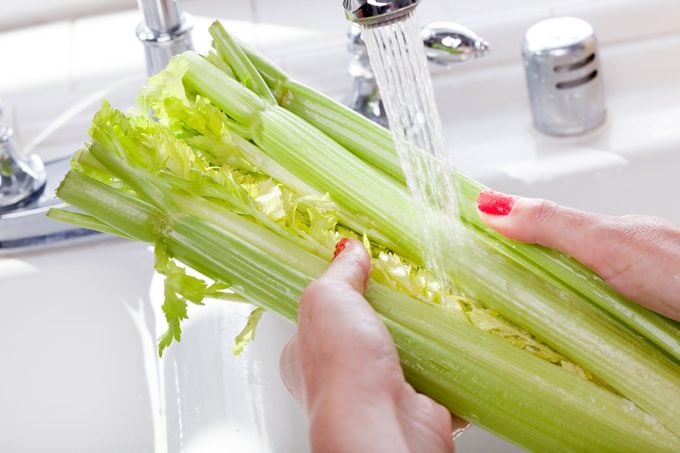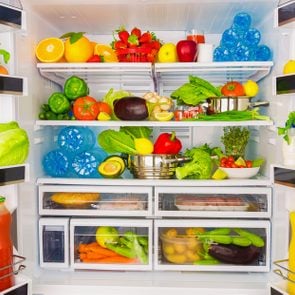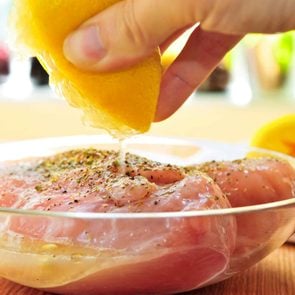4 Easy Tips for Safer Fruit and Vegetable Washing, from Food Safety and Nutrition Authorities
Updated: Jul. 06, 2022
Fresh produce is to blame for nearly half of food poisoning cases each year. Here, health experts help you brush up on wiser fruit and vegetable washing.
Why you need to wash your produce
Farmers’ market season is on its way, and maybe you’re already clearing space in the crisper drawer. But from the farmers’ market, the supermarket, and just about anywhere you shop to eat right, what you definitely don’t want is for your healthy haul to make you sick.
About 48 million Americans—that’s one in every six—get food poisoning each year, according to 2022 data from the Centers for Disease Control and Prevention (CDC). Of these, an average of 130,000 require hospital admission, and 3,000 result in death. And while undercooked meats and leftovers left unrefrigerated for just a little too long are common culprits, the United States Department of Agriculture (USDA) says your produce is behind almost half of all foodborne illness cases.
That’s not to say you should avoid these foods—in fact, preventing illness from plant foods can be simple. “It’s so important to wash your produce,” says Sally Twellman, RDN, LD, a registered dietitian at Heading Health in Austin, Texas. On the surface, Twellman says, washing produce is crucial for getting rid of pesticide and herbicide residue. These chemicals play a role in modern agriculture to control pests, weeds, and disease carriers—but they can also cause problems for the gut. “They’ll actually damage and kill the [good] GI bacteria that your body is working hard to maintain,” Twellman explains. Balancing the bacteria in your gastrointestinal tract has a big impact on your general health and wellness.
The chemicals can also damage the linings of our stomach and GI system, Twellman says. While research on all this is ongoing, a 2016 report published in Frontiers in Public Health noted that pesticide ingestion may interfere with a range of normal processes in the body, from nutrient absorption to endocrine function. These chemicals may also be linked to a greater risk of chronic illnesses like heart disease, dementia, and some cancers.
Another problem for produce? Bacteria. “Any fruit or vegetable that’s fresh will be exposed to microbes that occur naturally in the soil and the environment—and these bacteria hitch a ride on produce when it’s picked,” Twellman says. “[These microbes] will stay on the fruits and vegetables as they’re transported, and they can actually grow and multiply during transport.”
Some of these bacteria, such as species of E. coli, Salmonella, and Listeria, can do a number on your health:
- E. Coli can cause diarrhea and, in some cases, pretty severe illness.
- Salmonella can cause stomach problems alone; or in some cases a high, potentially life-threatening fever.
- Listeria affect the GI tract but can also spread to the blood or the brain.
Viruses like Hepatitis A and norovirus are common (but mild) causes of foodborne illness, too, according to the U.S. Food and Drug Administration (FDA).
(Next time you have a sour stomach, here’s how to tell if it’s food poisoning or something else.)
Do I have to wash all my produce?

Twellman says that when they’re available, she tends to splurge on the organic versions of produce to avoid excess pesticide exposure. But whether it’s organic or not, she suggests, it’s a good idea to wash all of your produce.
Certainly not every fruit and vegetable poses an equal risk. According to the Environmental Working Group—a consumer advocacy organization that rates and recommends foods, cleaning, and beauty products for health safety—some of the key fruits and vegetables to make sure you wash include strawberries, spinach, kale, collard and mustard greens, nectarines, apples, grapes, cherries, peaches, pears, peppers, celery, and tomatoes.
Twellman says it’s a good idea to wash food that you cut into, too—even if it has a rind, like a cantaloupe or watermelon. That’s because when the knife slices through the fruit or vegetable, microbes travel into the meaty part of the fruit, she explains. “I will even wash things like tangerines and oranges because after you peel them, whatever’s on the peel transfers to your hands and then to the actual fruit,” she says.
How to wash fruit and vegetables
Don’t pick up the dish soap just yet, Twellman suggests. Soap is what’s called an emulsifier, so it works to separate fat from water—which is super useful to remove cooking oil from your pans, but not that great for your produce. You don’t necessarily need special products, either. The best ingredients to clean your fruits and veggies are likely already in your kitchen.
1. Freshwater rinse
The FDA advises that you simply use running water to wash your fruits and vegetables, rubbing the produce to work off any microbes and pesticide residues (and to use a soft-bristle brush to scrub firmer foods like melons or cucumbers—just consider popping your scrub brush in your next dishwasher load to ensure it, too, gets a good cleaning).
2. Freshwater soak
Research published in the Journal of Food Protection said that in most cases, soaking produce for at least two minutes before rinsing may be even more effective in reducing harmful bacteria.
3. Vinegar soak
An older study from the same journal suggested adding a bit of vinegar to this soak works better to prevent food poisoning than water alone. “I like to use a five-percent solution,” Twellman says. That’s about one cup of vinegar to two gallons of water in your sink (but she notes that it doesn’t have to be super precise). “Then I just put all my produce in the water and let it sit for about 10 minutes, then lay it out to dry.”
Here are six other great uses for that white vinegar in your cabinet.
4. Baking soda soak
Research published in the Journal of Agricultural and Food Chemistry says that baking soda’s alkaline pH helps to break down stubborn pesticide residue. In the study, researchers soaked apples—reportedly one of the dirtiest fruits—in two cups of water with one teaspoon of baking soda for 15 minutes, followed by a freshwater rinse.
So, which is the best way to clean your produce?
The FDA and CDC say that in most cases, rinsing thoroughly with running water is effective in limiting your microbe and pesticide risk. If you’d like to be extra vigilant—especially if you’re prepping food for kids, older adults, pregnant women, or others with compromised immune systems—research suggests that adding vinegar or baking soda to a freshwater soak might go the extra mile.
Just remember that it’s important to wash your produce right before eating it—or else make sure it’s completely dry before storing. Any excess moisture can encourage fungal growth that spoils your food faster.
Subscribe to The Healthy newsletter for wellness insights delivered daily. Follow us on Facebook and Instagram—and, don’t miss:
- Nutrition Experts Share 6 Earth-Friendlier Ways to Enjoy Your Favorite Foods
- 7 Genius Nutrition Hacks a Dietitian Just Inspired Us to Try
- Cardiologists Just Cleared Up 7 Common—but Inaccurate—Beliefs about Heart Disease
- Is Magnesium Glycinate a Sleep Game-Changer? Here’s Why a Dietitian Gives This Supplement a Nod













